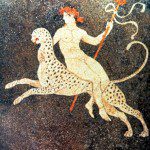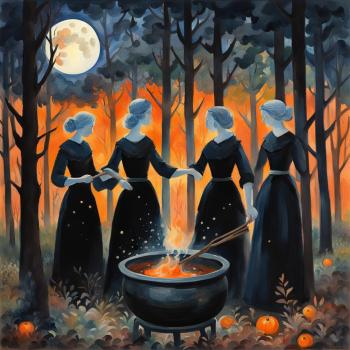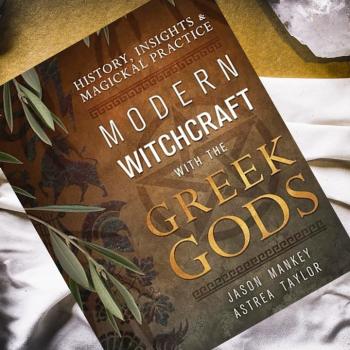
I’m sorry to be the bearer of bad news: memorization is just as important a skill in the practice and learning of the Craft as it was when you were studying at school. There’s so much to learn, how else are you going to learn it? Whether you’re trying to pick up a chant you enjoy, retain correspondence tables and the healing uses of herbs, or memorize the Charge of the Goddess so that you can recite it from memory, you still have to fix information in your mind and be able to spit it back out when you want to access it. But don’t worry! It’s not as hard as you think!
If you think of yourself as having a poor memory, it’s probably because you weren’t that great at studying for tests at school. Maybe you have a little ADD and you have trouble focusing on one thing. Or perhaps you know faces but names escape you.
You have been done a grave disservice. You see, not all of us learn in the same way. School and test-studying are designed for one particular type of learning style, and many of us just don’t match that. There are other ways to learn. The Craft is full of them, but most of us don’t use them in a productive way.
I’m going to share a couple of secrets with you. The first is that you actually do remember, at least on a subconscious level, everything that you experience. Your memory of it might be taken out of context, and it might be emotionally colored in weird ways, but you actually do retain it all. When we say we have poor memories, it’s not that we’re not writing our experiences to the hard drives we call our brains (not without altered states of consciousness or damage anyway) it’s that our directory system is inefficient or scrambled. Organize the directory system in a way that makes sense to you, and you’ll remember everything.
The second secret is that the more senses you bring to bear in retaining something you want to memorize, the more effectively you will do so. The reason why is because what you have now done is to add many tags to your brain’s search engine criteria. Instead of having to search for the chant you want under the tag “Stuff I’ve Read,” you can also find it under “Stuff I’ve Heard,” “Stuff I’ve Sung,” and “Stuff I’ve Drummed/Danced To,” and possibly even “Stuff I Associate with the Smell of a Campfire.” When you hear the rhythm you used again, or a tune that sounded like it, or moved in the way you originally moved (especially if it’s unique to that chant,) you are more likely to be able to find it in your memory’s databanks.
Mnemonics are “the process or technique of improving or developing the memory.”[1] Bards used many of these techniques to retain the wealth of information that they were required to know and share, long before the Celts had literacy. Here are a few time-honored methods that may help you or your students to recall the information you want, when you need it. Not all of them are going to work for everyone, but a few of them should work for you.
Repetition
Let’s get the obvious ones out of the way first. Repetition is still one of the most effective ways to memorize something. You repeat something until it becomes rote. Boring, you say? Well, do you know what? We use this far more than we think we do. What you’re thinking of is Biblical verses or multiplication tables, right? Well, how about driving to work? How about learning to drive in the first place? How about touch typing, or playing guitar, or karate, or dancing? How about walking? How about learning a chant or a favorite song? How about defeating World of Warcraft bosses? All of these can only be learned through repetition and rote memorization.
You can even put this to work in meeting people. One of the tips given to business people is to use the names of people you’ve been introduced to at least once and preferably at least three times, in conversation with them when you meet them. Actually speaking their names repeats the information and forces you to interact with it. You are far more likely to be able to call up that person’s name when you meet him or her again if you do this.
If you want to memorize something but writing just doesn’t work for you, record yourself reciting the information on your computer and play it back over and over again. It’s just like learning a popular song off the radio.
Taking Notes
Before the internet became commonplace, Witches were taught to keep a Book of Shadows. Part of the reason for this was to record dreams, experiences, ideas, and spells; but part of the reason was to copy out the correspondence tables from the one copy of 777 that three of you could get your hands on between you, or that you checked out of the library, knowing it would be missing the next time you tried to borrow it. People don’t do this anymore because we have Google. I love Google, but there’s a lot to be said for copying things down by hand. Schools know it and that’s why they keep making you do it, even though we’re deep into the Information Age now.
Why is this? Well, taking notes firstly has the benefit of repetition built in. You hear or read something, and you repeat it when you copy it out. Secondly, you bring more senses to bear than just your vision when you write. At the very least, you are adding a kinesthetic element (hand movements.) Even typing things out is helpful. If you’re really clever, you’ll do what many study guides suggest you do and a) read the information aloud before you write it, b) mumble the information to yourself as you’re writing it, and c) repeat it aloud when you’re done writing. This way, you have also added an auditory element.
However, I’m not going to tell you that doodling is bad like they do in school. Actually, drawing pictures while you’re taking notes brings your right brain into play along with your left brain and increases your chances of retaining the information, as long as your doodles directly relate to your subject and aren’t about something else. This helps to organize the directory I spoke of earlier; doodling about other things confuses it.
A personal illustration of the use of these two techniques together: I often included the second part of the Charge of the Goddess in rituals I performed, and after a full year of Sabbats, it started to become rote. I found that the better I had it memorized, the more effective it was as an invocation because I didn’t have to think about it. So I decided to memorize the whole thing. How I did it was this: on Day 1, I wrote out the first line and repeated it to myself over and over while I was at work (by myself in an office.) On Day 2, I wrote out the first two lines ten times and repeated them over and over. On Day 3, I wrote out the first three lines ten times and repeated them over and over. And so on. I now routinely recite the Charge at rituals off the top of my head and not only does it impress the Hel out of my newer students, it works as a quick-and-dirty invocation to the Goddess when you have nothing else planned that never fails to move any Witch.
Acronyms
I learned about this technique in music class. The lines on the musical notation graph are EGBDF. I know that because I remember the phrase, “Every Good Boy Deserves Fudge.” The spaces between spell FACE. I think I was five when I learned that. You see how easy it is to retain? The principle is simple: take the first letter of each word you are trying to memorize in a list, and make up a phrase that makes grammatical sense out of words that start, in sequence, with the same letter.
Here’s one that might be of particular use to us Pagans. You want to memorize the order of the planets in the solar system? How about this phrase: “My Very Educated Mother Just Served Us Nachos” (you could add “Pal” if you wanted, since Pluto is still acknowledged as a planet in most magick systems.)
You can do this numerically too. There’s a technique of trying to remember the sequence of pi by making a phrase using words that contain as many letters as the next number in the sequence. 3.14159265358979 can be encoded as “Now I need a drink, alcoholic of course, after the heavy lectures involving quantum mechanics.”
Linkwords
This is a technique that was developed to learn foreign languages. You come up with a word or phrase in your language of origin and link it in a sentence or a visual with what the foreign word means. The site gives examples but let me show you how to apply it by inventing one of my own. Ceremonial magicians use a lot of Hebrew. The Hebrew word Mahlkut or Malkuth means “kingdom.” It sounds kind of silly when you think deeply about it, but I bet it will stick with you: “Mal, the old coot, thinks it’s his kingdom,” or “Mal the Uncouth thinks it’s his kingdom.” (And I bet that will be an earworm you’ll try to forget, but can’t.)
Method of Loci
This technique from the ancients of Greece and Rome involves creating a visual of a place in your mind’s eye and then associating the things you’d like to remember with those imagined places. You’ve probably seen this depicted in TV shows, but it’s an old technique. Want to remember how the altar is set up? Why not visualize an altar in an astral temple? How about where the symbols for the elements are supposed to be located on a pentagram, or where the reclaimed qualities of the Iron Pentacle are located? I visualize my astral temple as a circular building with a pentagram drawn in the center of it. At the bottom left corner is a tree; at the upper left corner is a huge, smoldering incense censer; at the upper right corner is a fountain; at the bottom right corner is a brightly burning brazier; and at the top is an open window facing a cosmic scene full of stars and nebulae.
Rhyming
Doreen Valiente was no fool when she wrote, “To bind the spell every time, let the spell be spake in rhyme.” Repeating a little ditty makes for an effective spell because we don’t forget it; and this is just as good for maintaining information. It’s pretty easy to memorize the Witches’ Rune or the Ancient Call, because we remember:
Darksome night and shining moon,
East and south and west and north,
Harken to the witches’ rune,
Here we come to call ye forth
Can’t remember what order to touch your shoulders in during the LBRP? The Catholics had this figured out: “Spectacles, testicles, wallet (left breast pocket,) watch (right breast pocket.)”
Having trouble remembering which months have 30 or 31 days so that you can plan the next Sabbat? This is an oldie but a goodie:
Thirty days hath September,
April, June, and November;
All the rest have thirty-one,
Save February, with twenty-eight days clear,
And twenty-nine each leap year.
Music
If you are very creative or you learn better by listening than reading, this is the best tool I know. How I learned the Witches’ Rune was by listening to and learning to sing a song by Spiral Dance, who put it to music with close to the original words and a tune that sticks with me. Tradition members of mine wrote a chant out of the words of the LBRP for this same purpose.
Dance and Movement
You can make up a series of movements or a dance to represent what you’re trying to remember. Have different movements to represent the elements in an elemental chant, perhaps. As another example, I know of a series of movements for the Goddess Chant (“Isis Astarte”) that mimics statues of those particular goddesses.
You can also use a kinetic frame of reference. Do you have trouble remembering which way is deosil and which is widdershins? You’re not alone. Here’s a good rule of thumb; point your right hand to the center of the circle to move deosil and your left to move widdershins.
Visualization Techniques
One mnemonic technique that is suggested to help English-speakers learned gendered languages, such as French or Spanish, is to color-code the visual association. For example, to remember the Spanish word for “foot,” which is “pie,” a suggested visualization is to have a foot step on a pie, which squishes out blue filling (blue indicating that pie is a “male” word.)
Visualized associations can be useful. For instance, I memorized the associated metals of each planet by visualizing that planetary symbol in the proper metal. For example, Venus’ associated metal is copper:

Ultimately, the key is to enlist the help of your creative mind in memorization, rather than set it against you. I hope some of these techniques benefit you and your students – and me and my students – alike!
Next column: An Elemental Journey
[1] Dictionary.com. http://dictionary.reference.com/browse/mnemonics?s=t, accessed February 14, 2014.
Seekers and Guides is published on alternate Mondays. Follow it via RSS or e-mail!













